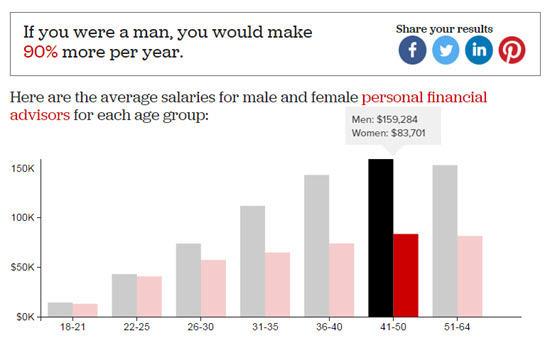 The headline is hardly a shocker: Pay Gap Even Higher Among Women in Elite Jobs, as the Daily Beast points its readers to a Wall Street Journal study that examines the gender pay gap across 446 occupations.
The headline is hardly a shocker: Pay Gap Even Higher Among Women in Elite Jobs, as the Daily Beast points its readers to a Wall Street Journal study that examines the gender pay gap across 446 occupations.
These occupations include “doctors, compensation managers, and personal financial advisers,” as the article offers obvious reasons for the glass ceiling among highly educated women. And those reasons are no different than those applicable to women in general.
Specifically:
There are a variety of factors that contribute to the higher wage gap… including maternity leave preventing women from advancing their careers.
Right.
Same old, same old.
By way of example, the WSJ Blog notes:
Male doctors working full time earned about $210,000 annually on average for the five years through 2014… Female physicians made 64% of that, about $135,000 a year. Among personal financial advisers, men took in about $100,000 while women made about $62,000.
Now… Let’s admit that these figures — $62k versus $100k, and even $135k versus $210k — result in different lifestyles depending on where you live, and whether or not you are an unincorporated independent or a salaried employee. But more on that in a moment.
His and Hers. Not a Pretty Picture.
As much as the glass ceiling annoys me from where I sit — no glass in sight — and however much its persistence irks me in retrospect, gazing back at my years in corporate America, let’s not forget the bigger picture. In that bigger picture, I find myself more concerned about the middle and low income earners where the gap hugely impacts basic quality of life.
Does that mean I’m not furious that on average, a male personal financial adviser makes 90% more than a female in the 41-50 age range, which is data I saw a few months back?
Of course not. And yes, you will do a double-take viewing this graphic from Motto-Time’s Pay Gap Calculator.
The dramatic disparity is impossible to miss: A male financial adviser earns nearly double what his female counterpart earns in the highlighted age bracket.
What about the fact that the physicians / surgeons category in the same age demographic reflects a 48% pay gap, with men pulling in roughly $85,000/year more than women?
From the same Motto-Time Pay Gap Calculator:
… estimates for physicians and surgeons, age 41-50, are based on a national sample of 6,885 men and 3,751 women. Our estimate of the average salaries is $261,601 ± $2,988 for men and $176,985 ± $3,826 for women at 90 percent confidence intervals.
Pretty dreadful. And should you be interested, you might find this 2015 Science Daily brief consternation-worthy as it describes “priorities” as possible reasoning for pay discrepancies among male and female surgeons. Again, I say “same old, same old.”
 Still, unless she’s trying to feed four kids on a single income, I doubt the female physician salaried at $177,000/year is having to choose between rent or food on the table. And you may recall my astonishment at the data on anything but an elite job — retail sales — as the gender pay disparity in its 41-50 range reflects the average male salary at roughly $55k versus the female salary at $26k.
Still, unless she’s trying to feed four kids on a single income, I doubt the female physician salaried at $177,000/year is having to choose between rent or food on the table. And you may recall my astonishment at the data on anything but an elite job — retail sales — as the gender pay disparity in its 41-50 range reflects the average male salary at roughly $55k versus the female salary at $26k.
Uh-huh. Women in retail sales on average earn half the man’s salary. More to the point: Ever tried to feed a family on $26,000/year?
It’s rough. Very rough. You make choices between food, a roof, medical and dental care. You deny your children opportunities — that’s opportunities, not “things” — hoping tough times will eventually yield to something better, and you do everything you can to expedite that something better.
Unless you’re staring at a dead end and you know it.
Hello, Perspective? Are We There Yet?
The glass ceiling for top jobs in “elite” fields?
Sure, it bugs me. It should bug you, too. It’s wrong, systemic, pervasive — and far worse for women of color. And if it isn’t you personally who is dealt the short end of this stick, remember that it may be your daughter, your wife, your sister, your aunt, or your best friend.
Those years of lower earnings — because of starting out at lower rates of pay — are hard to come back from. Likewise, those years of lower earnings whether or not you ever stopped working while raising children.
But let’s get real. Federal minimum wage ($7.25) and state minimum wage figures?
Try managing on $7.25/hour, or $8 or $10/hour. Can you manage a family on a gross of $320 to $400/week? (That’s before taxes. Keep that in mind. And see just how appalling the current rates are on this minimum wage chart by state.)
And what about those without actual employers, i.e. no employment relationship? Do you understand the implications?
Uncertain why that employment relationship matters in the U. S.?
“Employment” Has Advantages
Typically, an employment relationship means that the organization employing you is picking up some critical costs that include: half your Social Security/Medicare tax; unemployment insurance deduction/tax; a number of paid holidays, vacation, and sick days. You may also be eligible for family leave (FMLA), matching of various savings plans (401(k), 403(b), etc.), and you may be provided a base level of life insurance as well as the all-important monies toward medical insurance premiums.
Trust me — these amounts add up to many thousands of dollars. Why do you think so many employers are choosing to hire contractors rather than employees?
They don’t have to pick up these costs.
Incidentally, the list above is not exhaustive; this payroll tax source explains clearly.
And without an employment relationship? You cover these costs yourself, typically at much higher rates as an individual, or you do without these benefits entirely. (Debates over paid or unpaid maternity / paternity leave in the workplace? Irrelevant.)
Welcome to the world of the contractor, the so-called portfolio worker, also known as the contingent workforce, 1099 workforce, or the “on demand” workforce… with some estimates as high as 53 million people in the US.
In case you’re confused (you aren’t alone), the contingent workforce is typically categorized as comprised of temporary and “non standard” positions, and it is somewhat broader than the 1099 workforce, which is defined in this Aspen Institute Report as follows:
“1099 workers” are those whose income is reported for tax purposes on a 1099 form (as opposed to a W-2 for wage and salary employees). They also are known as independent contractors, freelancers, and the self-employed.
The “unincorporated self-employed” — those of us who receive 1099s working as individual consultants, contractors and freelancers, without any employees — number roughly 10 million.
“Discouraged” Worker?
Discouraging?
You tell me. But while I’m on the subject of the American workforce, let’s throw this into the mix — a May 2016 Bureau of Labor Statistics report that reminds us:
… the number of unemployed persons [in April 2016] was little changed at 7.9 million.
And…
The number of persons employed part time for economic reasons (also referred to as involuntary part-time workers) was about unchanged in April at 6.0 million and has shown little movement since November. These individuals, who would have preferred full-time employment, were working part time because their hours had been cut back or because they were unable to find a full-time job.
And…
In April, 1.7 million persons were marginally attached to the labor force… These individuals were not in the labor force, wanted and were available for work, and had looked for a job sometime in the prior 12 months.
New Math? Looks Old to Me!
Might we sum those figures?
10 million + 7.9 million + 6 million + 1.7 million…
 That’s more than 25 million people. At least 15 million of them (if not far more) are living a precarious financial position. And that’s without looking at the numbers of both men and women trying to live on one or more full-time minimum wage jobs.
That’s more than 25 million people. At least 15 million of them (if not far more) are living a precarious financial position. And that’s without looking at the numbers of both men and women trying to live on one or more full-time minimum wage jobs.
Perhaps these figures explain why I’m not as hot under the collar over the “elite” gender pay gap as I am over other economic disparities, in particular the numbers of women impacted by the pay gap in non-elite jobs. And then we have the gross inequities by ethnic group, some of which are mentioned here, and more of which are dispassionately included in the various BLS economic reports published monthly.
Although I’m glad to see continuing media attention to any and all issues of inequity, just how long will it take us to address them? And not just for those with the standard “employment relationship” and assumptions about workplace infrastructure, but infrastructure for those without traditional employers?
I welcome your thoughts.
You May Also Enjoy

Leave a Reply